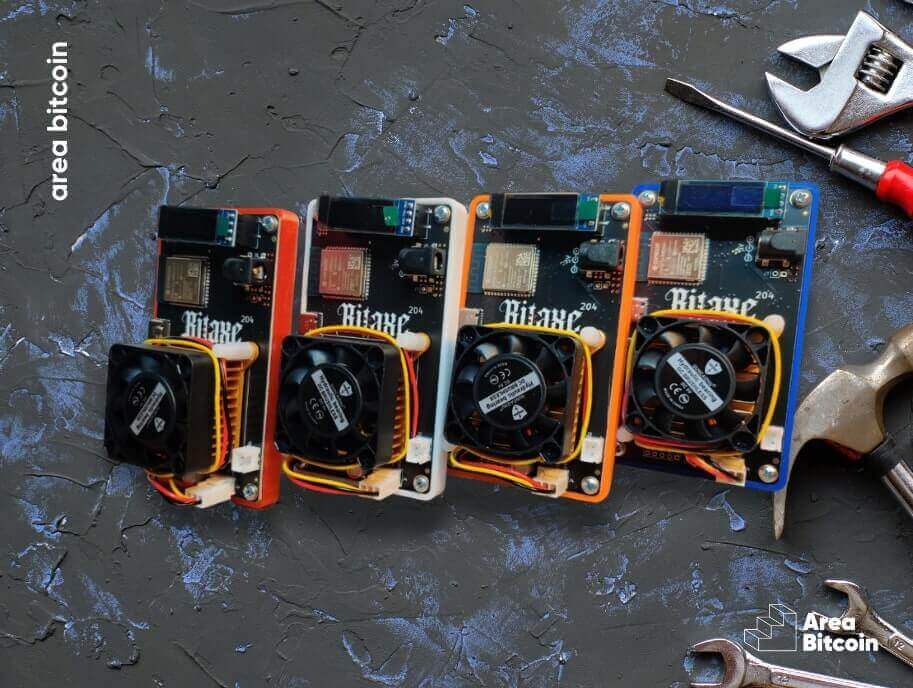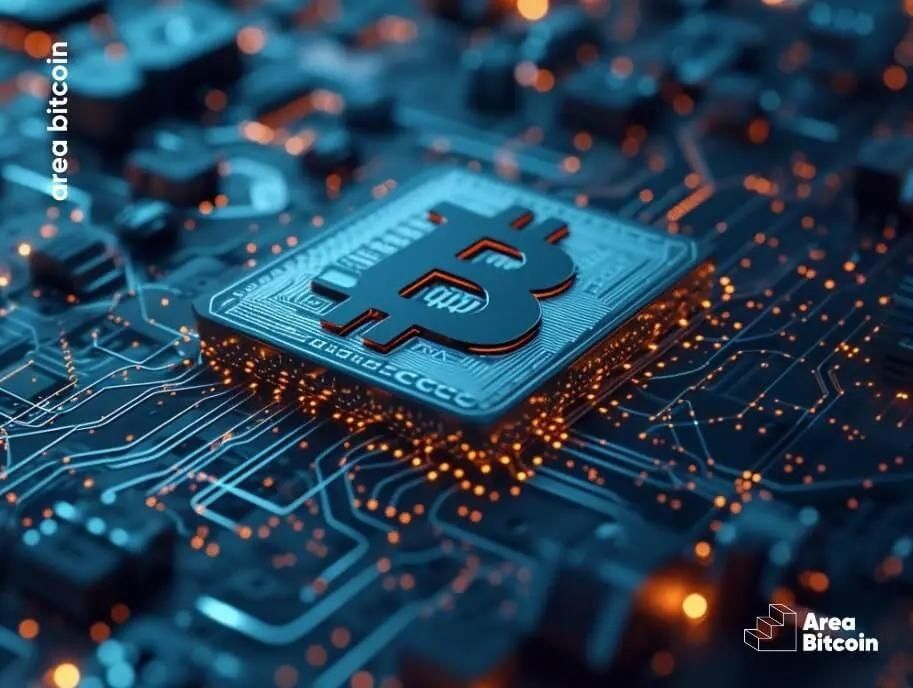In July 2024, a piece of news dominated the X platform: a solo miner managed to find a block and receive a reward of over $200,000. But how was this possible? By using Bitaxes!
And that was enough for this small and powerful hardware device to gain fame among the public.
Mining has long fascinated Bitcoiners worldwide; after all, who wouldn’t want to earn Bitcoin for free and without KYC? If this once seemed like a distant dream, Bitaxe has rekindled the hope of solo mining, conducted directly from home, at a low cost, and in an open-source manner.
The philosophy of Bitcoin is deeply rooted in decentralization and the possibility for anyone to operate their own node, promoting individual sovereignty. However, there are criticisms of Bitcoin mining today, especially regarding the lack of competition among mining hardware manufacturers and the centralization of mining pools.
In Bitcoin’s early days, when Satoshi Nakamoto launched the network, miners used CPUs, i.e., simple computers, to mine. However, over time, they began using GPUs and later FPGAs.
During that period, mining was less commercial and more collaborative, with users sharing software designs and configurations. Discussions on the Bitcoin Talk forum at that time revealed a much more open environment, where everything was open-source and accessible to anyone.
The introduction of ASIC machines brought a significant change. Developing and producing ASICs is expensive and requires significant investments, which moved mining out of the hands of ordinary individuals, turning it into a highly profitable business.
While economically sensible, especially in a mature market with several companies developing ASICs, there is still room to make mining more accessible.
This is where Bitaxe comes in, aiming to allow Bitcoiners to explore mining more openly and accessibly, reviving the initial spirit of open source and information sharing.
Let’s dive deeper into what Bitaxe is all about.
What is Bitaxe?
Bitaxe is the first open-source ASIC mining hardware for Bitcoin. This means that anyone can access, modify, and customize Bitaxe according to their needs, making Bitcoin mining more accessible and efficient for everyone.
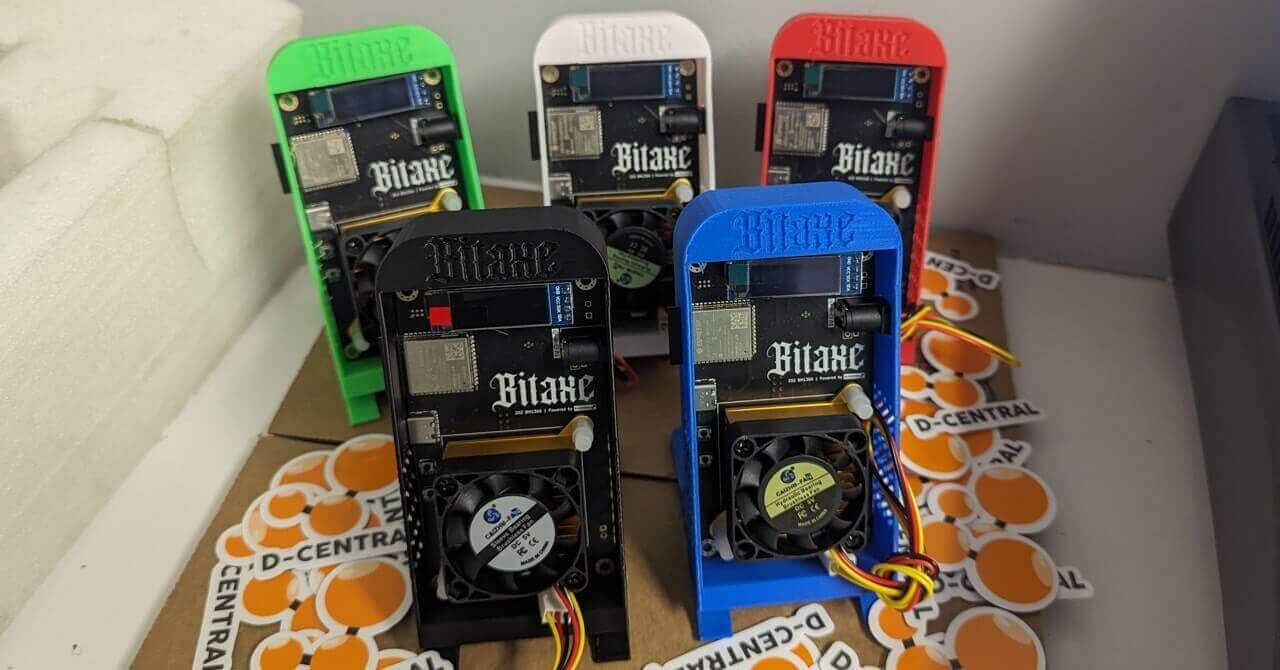
This small ASIC miner supports both solo and pool mining, allowing users to choose the approach that best suits their needs and preferences.
With Bitaxe, you not only help secure the Bitcoin network but also promote decentralization and diversity in the mining ecosystem.
Moreover, Bitaxe is an economical solution for those who want to enter the world of Bitcoin mining. Whether you are an experienced miner or a curious novice, this miner offers a unique opportunity to contribute to the Bitcoin network and potentially profit from mining.
Who created Bitaxe?
Bitaxe was created by Skot, an electrical engineer with extensive experience in electronics.
His interest in open-source systems began in high school when he lived in a small town with few radio stations playing music that he and his friends didn’t enjoy.
So, they decided to build their own FM radio transmitters using information available online. They managed to get the radio on the air and broadcast to their neighbors, but they faced some legal barriers in the process.
Years later, Skot discovered Bitcoin and noticed that no one was creating open-source home miners. Even without knowing how or where to start, he decided to dive into the idea.
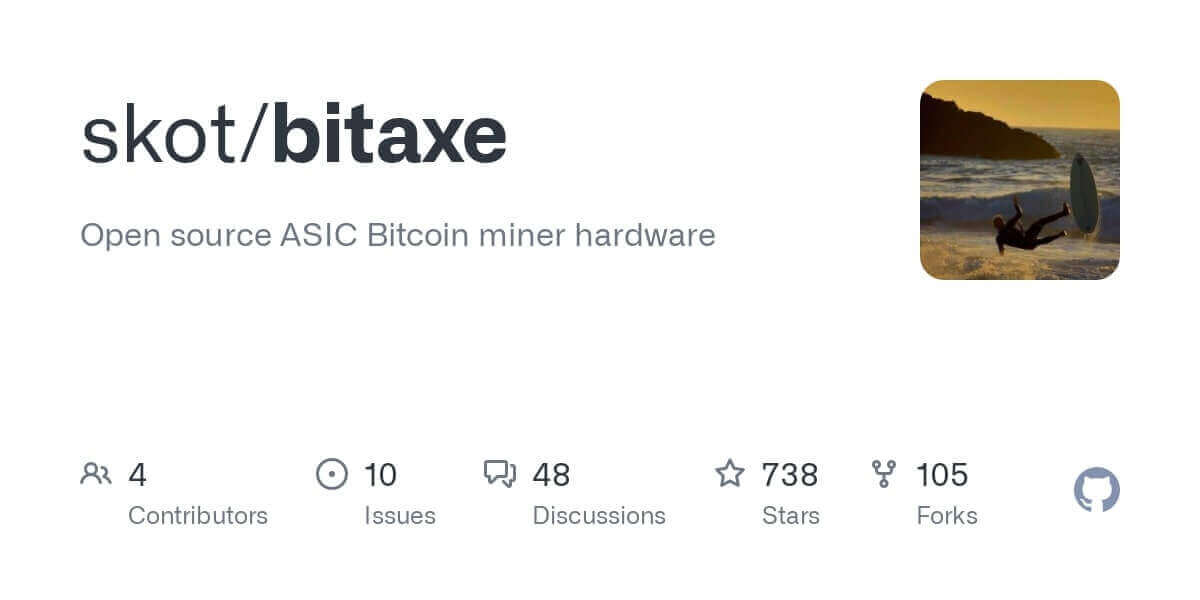
However, the project grew, and Skot is no longer working alone. Bitaxe is now developed with the help of the Open Source Miners United group, which has about 2,500 members.
Challenges of Open-Source Bitcoin Mining
Currently, besides Bitaxe, which is still a small initiative, there is no other open-source mining hardware or firmware for Bitcoin. This absence is notable, considering that Bitcoin itself is inherently an open-source technology.
The primary reason for the lack of open-source projects in Bitcoin mining is the high cost and risk associated with developing ASICs (Application-Specific Integrated Circuits).
Developing these chips requires significant capital investment, often in the tens of millions of dollars, along with years of development and large teams. Therefore, companies that make these investments are generally not comfortable sharing their technologies, as this would compromise their business models and financial returns.
Another factor is the focus of ASIC developers on large-scale industrial miners. These machines are designed to operate in industrial data centers, being noisy, hot, and requiring robust electrical infrastructure, making them unviable for typical home use.
These large industrial miners constitute a more lucrative market for ASIC manufacturers. As a result, the equipment is optimized to maximize efficiency and performance on a large scale, often to the detriment of the needs of individual miners.
All this considered, Bitaxe emerges as a beacon of hope, returning to the collaborative and open-source roots of Bitcoin mining, offering an alternative for those who wish to explore and contribute to Bitcoin mining in a more accessible and transparent manner.
The development process of Bitaxe
To create Bitaxe, Skot started by acquiring an Antminer S9 and began the process of reverse engineering due to the lack of available documentation. These ASIC chips are not designed to be used independently, requiring a meticulous approach.
Skot used oscilloscopes, logic analyzers, and other equipment to understand how they worked and to learn more about Bitcoin mining.
What is Reverse Engineering?
Reverse engineering in the field of electronics is the process of disassembling and analyzing electronic components, circuits, and systems to understand their internal functioning.
This process may involve the physical disassembly of devices, the analysis of integrated circuits, the extraction of firmware codes and embedded software, and the creation of schematic diagrams from the observed components.
As time passed, the S17 chip became more accessible and available on the market. Skot was able to order some of these chips directly from China, carefully measured them, and created his own datasheet.
He analyzed the pin connections based on the Antminer’s design, allowing him to assemble a rudimentary breakout board with exposed pins. This enabled the chip to be connected to a computer for a better understanding of how it worked.
The importance of Reverse Engineering
Many electronic components come with data that clearly explains what voltages to use, what each pin does, and the mechanical parameters. However, this is not the case for these ASIC chips, which are not available on the open market and are exclusive to Antminers.
Therefore, reverse engineering was essential to uncover how they worked.
Other projects and initiatives
Skot is not the only person doing this type of work. Third-party firmware projects for Antminers, like Brains, Luxor, and Epic, have also involved reverse engineering the chips and protocols to create their own firmware.
However, Skot took a different approach. Instead of developing commercial firmware for Antminers, he extracted a chip from an S19, which contains about 320 chips, and installed it on his own circuit board with a dedicated power supply. This allowed the chip to operate independently of the rest of the Antminer.
This initiative not only demonstrates the technical feasibility of working with these chips independently but also opens the door for other developers to explore new possibilities in Bitcoin mining, reviving the initial spirit of experimentation and innovation within the Bitcoin ecosystem.
Bitaxe features
Bitaxe is a compact device, about the size of a Raspberry Pi.
A Bitaxe consists of:
- A circuit board
- A fan for heat dissipation
- A small screen to monitor the mining process
- A power supply
But undoubtedly, the key component of Bitaxe is the chip.
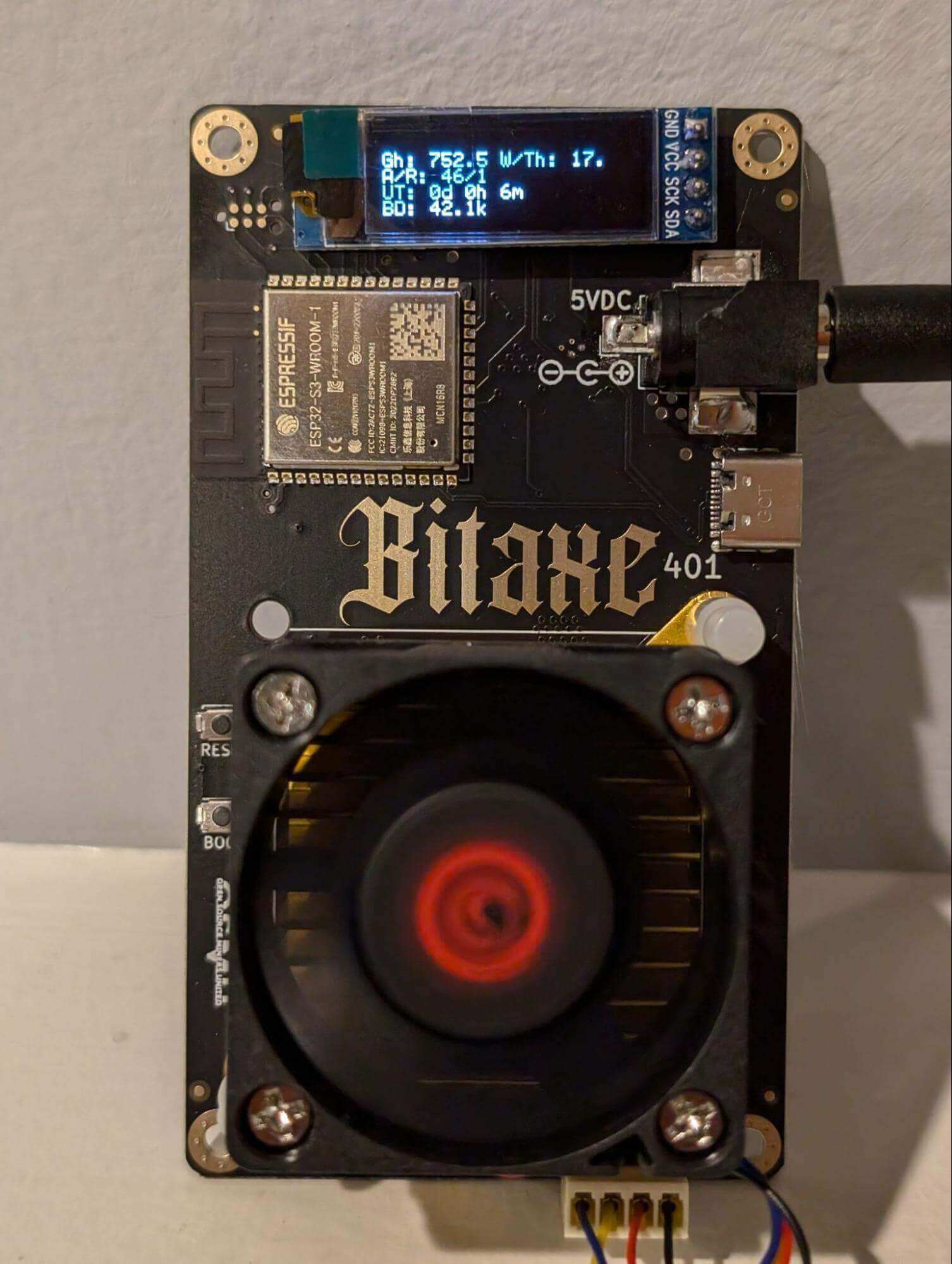
1. Chip
At the heart of Bitaxe is the efficient Bitmain BM1397 ASIC chip, which provides a high hash rate and low power consumption.
The chips used in the latest version of Bitaxe, the Bitaxe Supra, come from the Antminer S21 model, as shown in the image below.
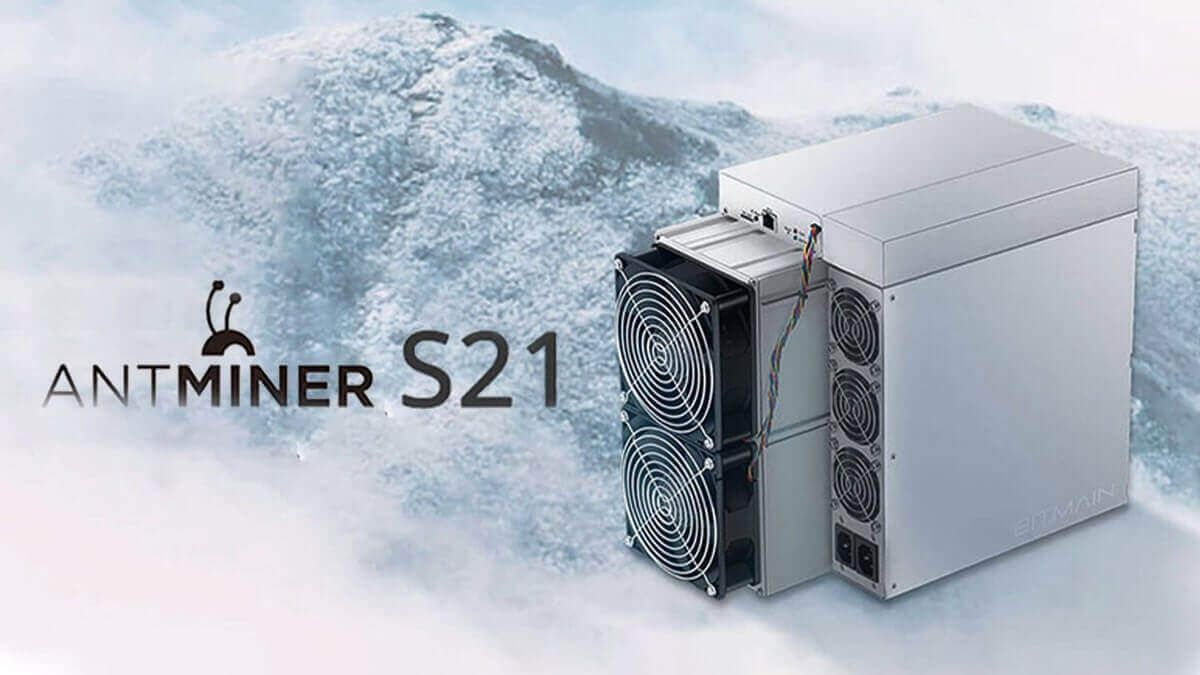
Thanks to this configuration, Bitaxe achieves an efficiency of 17.5 watts per terahash. However, the total hash rate of Bitaxe is significantly lower than that of an S21, as it uses only 1/324 of the chips.
In summary, Bitaxe reaches the maximum hash rate that a single chip can offer, which is approximately three-quarters of a terahash, or 750 gigahash.
2. Power Consumption
One advantage of this device is its quiet and discreet operation. With a consumption of only 12 watts, similar to a cell phone charger, Bitaxe generates neither noise nor heat, making its cost practically imperceptible on your electricity bill.
3. Automatic Adjustment
One of the most interesting features of Bitaxe is its automatic adjustment capability.
This feature allows the miner to automatically adjust power, heat, and efficiency settings, optimizing its performance without the need for constant manual intervention. This way, users can maximize the miner’s potential, whether in small-scale mining operations or in mining pools.
Now that we’ve covered some of the main features of this small miner, let’s see how you can set up your own.
How to set up a Bitaxe? (Practical Guide)
Before explaining how to set up Bitaxe, it’s important to note that there are two ways to get one:
1. Building Your Own at Home (DIY)
All design files for Bitaxe are open-source and available on the bitaxe.org website. So, if you have technical skills and experience in electronic soldering, you can download the files, have the circuit boards manufactured in China at a very low cost, and order the parts online.
The website also provides a complete list of all the necessary components and an explanatory document detailing the essential tools for assembly.
Many people have chosen this route and successfully built their own Bitaxe, including beginners in electronic soldering, demonstrating the project’s viability. This is a self-sufficient mining method where you build your equipment from scratch.
2. Buying a Pre-Assembled Bitaxe
For those who prefer a ready-made solution, the Bitaxe website lists stores that sell this small miner already assembled.
It’s important to mention that these stores respect the open-source license, giving due credit to the project and maintaining the original specifications.
There are sellers in North America, Europe, Australia, and China.
When you visit the site, you can check the prices and choose the option that best suits your needs.
When you buy from one of these sellers, you’ll receive a Bitaxe by mail, fully assembled, in the box, with a power supply, and ready to use. Some sellers also offer desktop stands or cases to conceal the circuit board, depending on your preference.
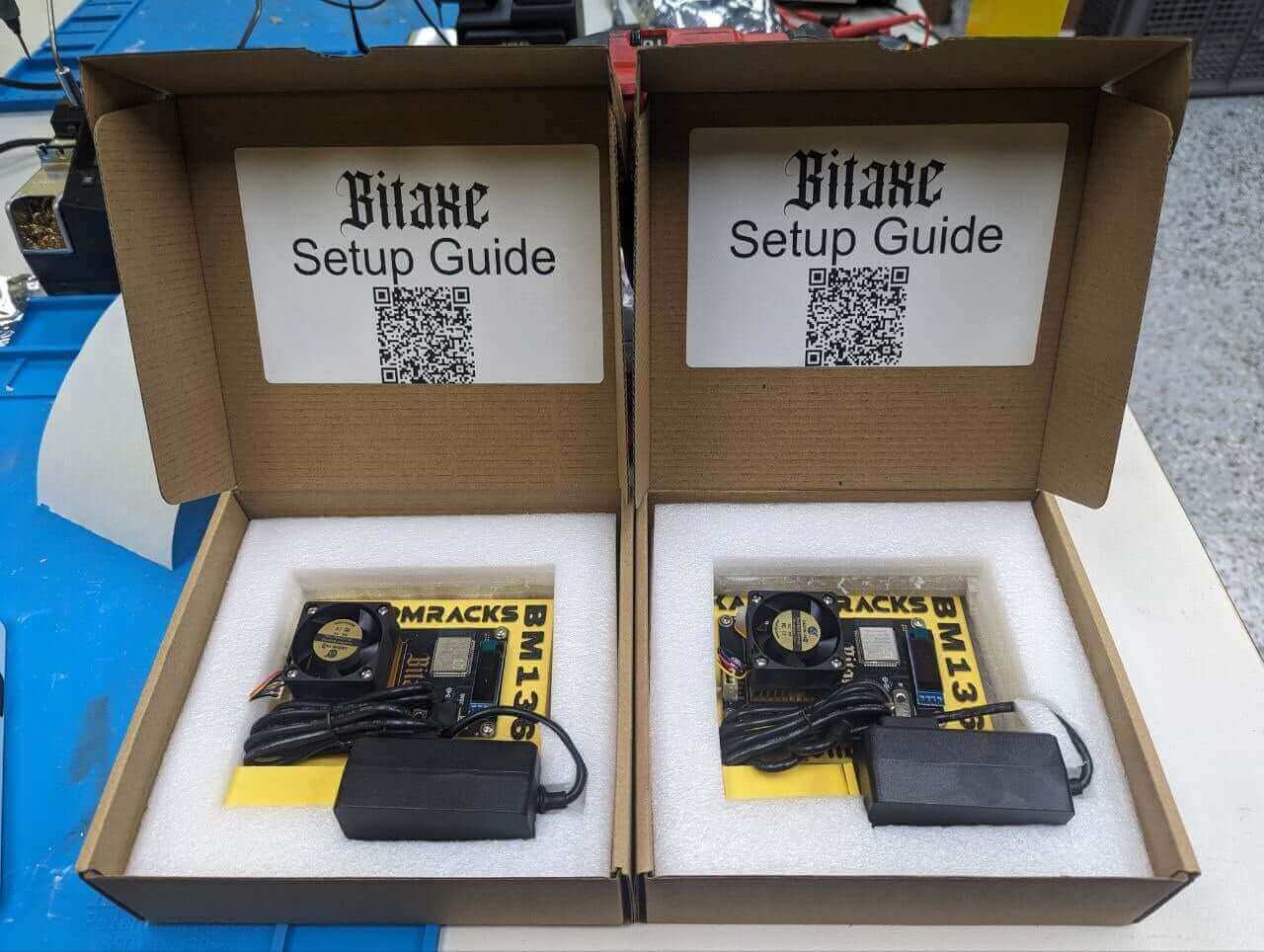
Setting up a pre-assembled Bitaxe
Step 1: Connecting to WiFi
To start using Bitaxe, the first step is to connect it to your WiFi network, as it operates exclusively via WiFi.
On the Bitaxe screen, a WiFi network will appear for you to connect to. Use your phone or computer to connect to this network created by Bitaxe.
Next, a screen will automatically appear, prompting you to enter your home WiFi credentials so the miner can connect to your network.
Simply enter your WiFi network name and password.
At this point, you can also define the Stratum mining pool you want to use by entering your username, password, and other operating parameters. If you prefer, you can adjust these settings later. The crucial step is to click “save” so the device restarts and connects to your network.
Step 2: Accessing the AxeOS Dashboard
Bitaxe comes pre-configured with defaults that allow you to start mining immediately if you wish.
However, it’s recommended to note the IP address displayed on the screen, type it into your browser while connected to your network, and access the complete Bitaxe dashboard, known as AxeOS.
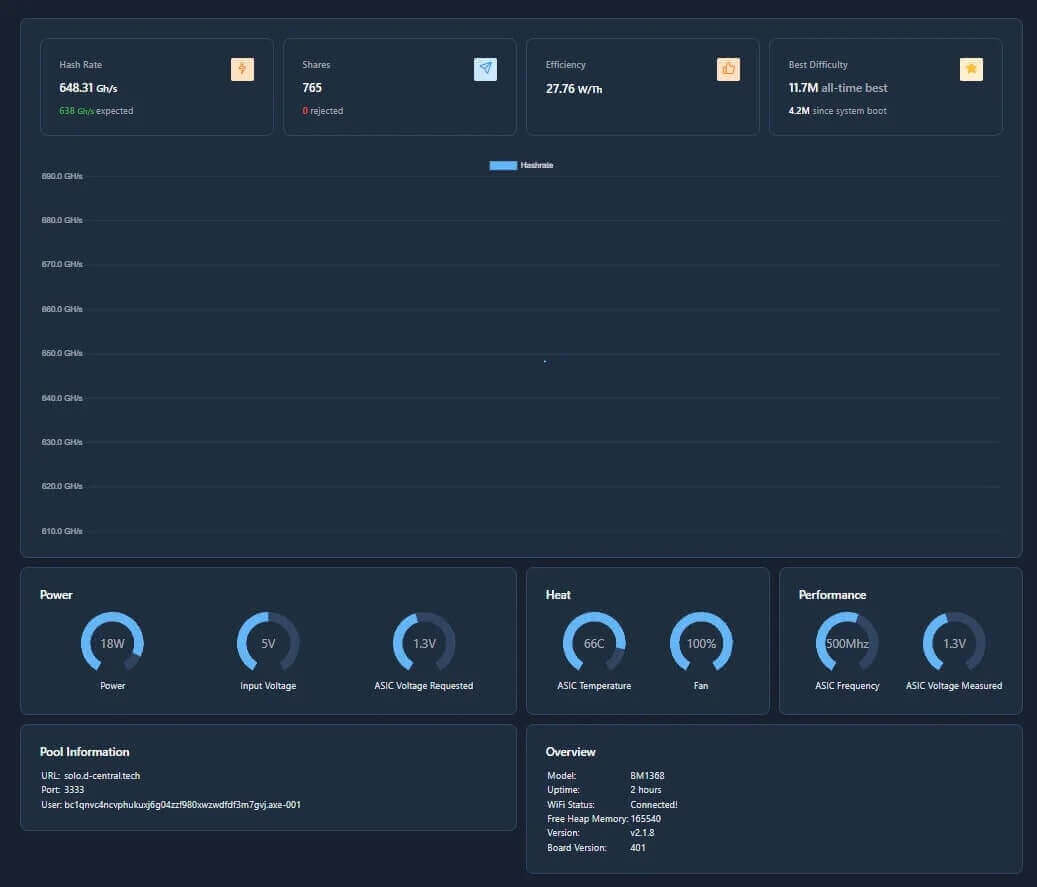
This panel provides all the necessary mining statistics, allowing you to check your performance, best difficulty achieved, temperature, fan speed, and other important information.
Step 3: Connecting to a pool
In the AxeOS dashboard, you can also configure your Stratum information using Stratum v1, which is compatible with any pool that supports this protocol.
This way, you can choose to mine solo or connect to a mining pool.
Additionally, it is recommended to choose a pool that is not a proxy pool. Here are two pool suggestions for you to connect to:
- CK Pool: an open-source solo mining pool.
- Public Pool: another solo mining pool, very easy to host. It’s a one-click installation on Umbrel. You can install Umbrel and then install your own solo mining pool with one click, point your Bitaxe to it, and thus have an end-to-end sovereign money system.
Now, just leave your small miner running! Once configured, Bitaxe will start mining and continue to operate continuously. It has a small front screen that allows you to monitor its operation without constantly needing to access the dashboard.
Related article: Nerdminer: What is it? How does it work?
Can you make money with Bitaxe?
This is one of the biggest questions for those interested in solo Bitcoin mining. So, can you make money mining from home using Bitaxe?
You should consider this type of mining as “lottery mining.” When mining individually, you have an extremely low chance of obtaining the full block reward, which can exceed $200,000 depending on the value of Bitcoin.
To illustrate the improbability, if you keep Bitaxe running for an entire day, your probability of solving a block is about one in eight million. In other words, it’s like winning the lottery! The cash prize is also similar to the lottery, varying according to the price of Bitcoin.
However, it’s interesting to note that by keeping your mining equipment running continuously, it’s as if you’re buying a lottery ticket every day.
And indeed, there was one lucky miner who achieved this feat.
In July 2024, a miner found a Bitcoin block using, apparently, 6 Bitaxes. He started mining 19 days before the event, and only 24 hours before finding the block, he connected a series of other Bitaxes, increasing his hash rate to 3 TH.
As you can see below, the block found was 853742.
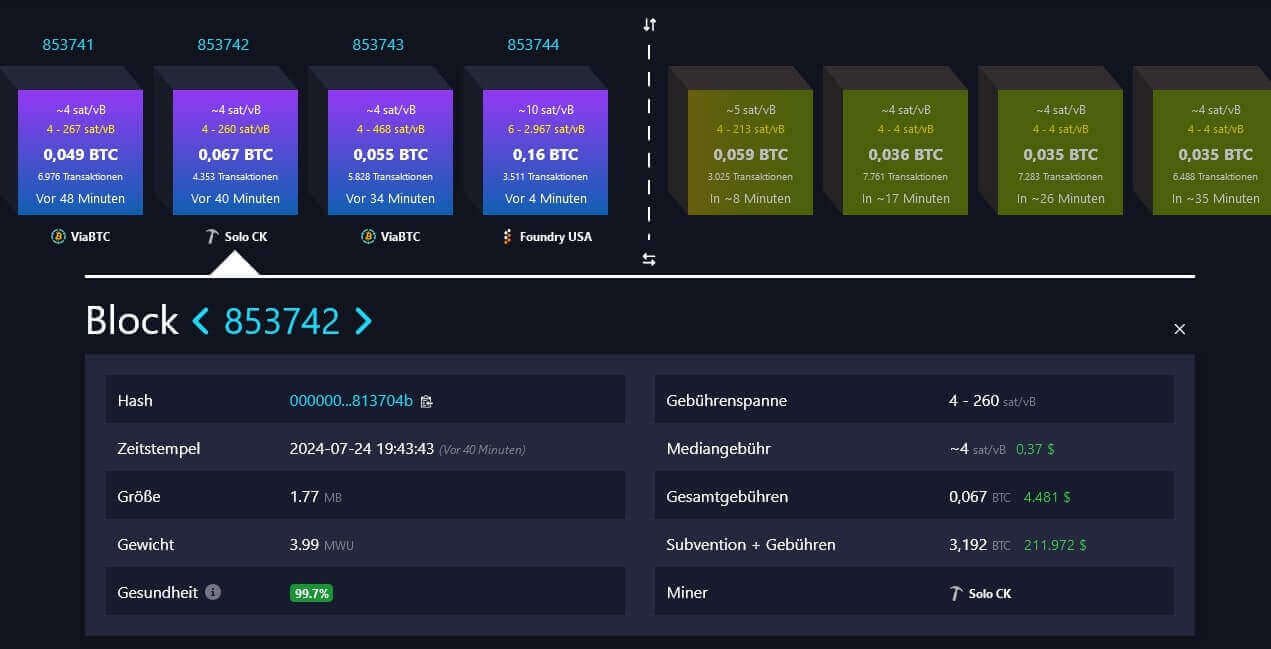
As a result, this miner received a reward of $212,000!
Lucky, right?!
This block has already made history and rekindled the hope of many Bitcoiners in being able to mine Bitcoin from their homes and receive a reward.
I want to buy a Bitaxe, but how much does it cost?
Today, you can find Bitaxes available for purchase in stores worldwide for an average price of $150. Be sure to check for additional taxes and fees, which may vary depending on your country.
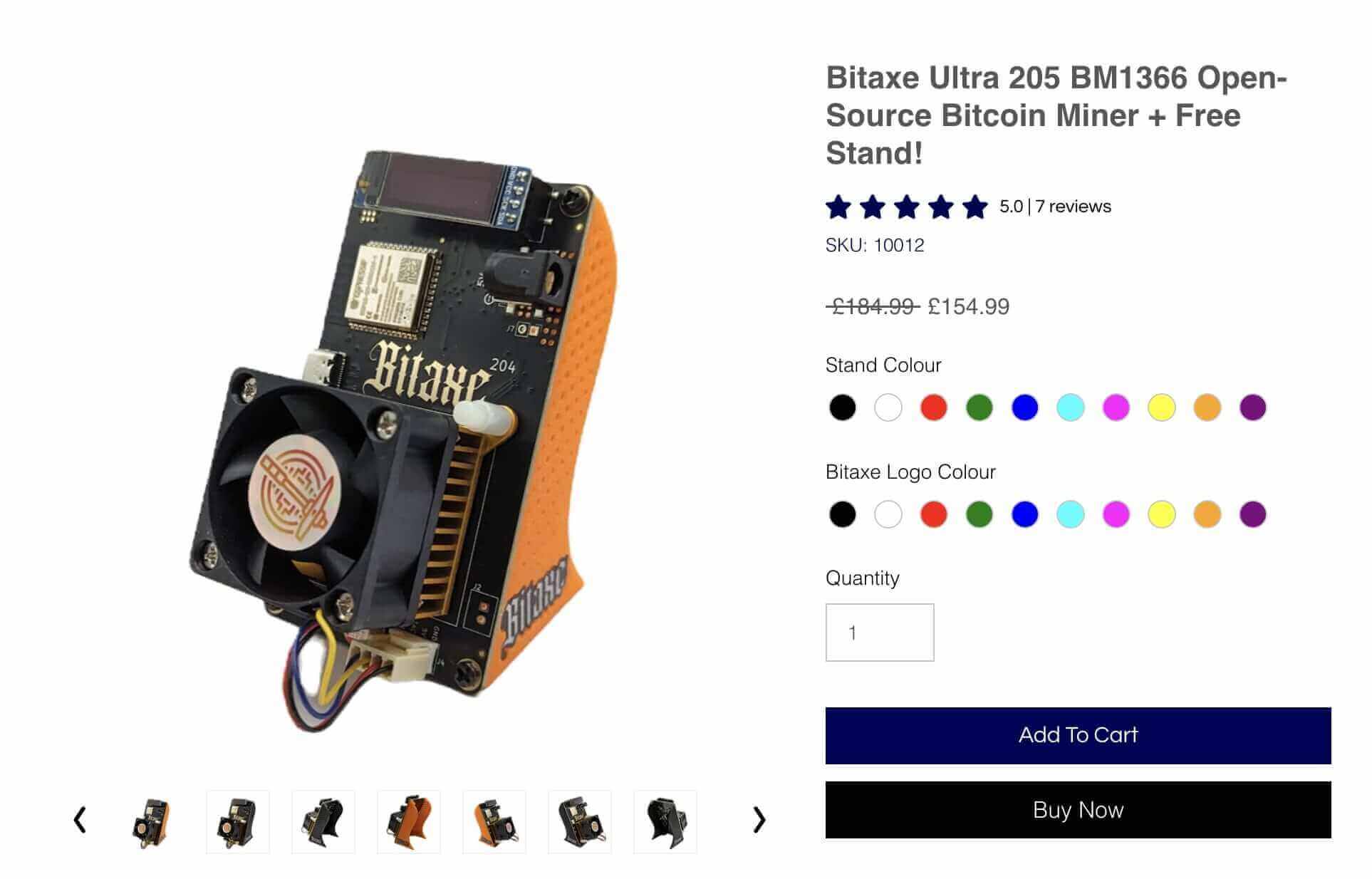
This is a super affordable price compared to a typical ASIC machine, which costs an average of $4,000.
Thus, Bitaxe makes it possible for more people to experience Bitcoin mining firsthand and even dream of finding a block and receiving a reward for it.
How can Bitaxe revolutionize Bitcoin mining?
Imagine if millions of people worldwide started mining with Bitaxe. What would be the impact on the current size of the Bitcoin network?
Let’s explore this idea!
One exahash corresponds to one million terahashes. So, if we had a million Bitaxes operating at one terahash each, we would reach one exahash.
With the current network difficulty (as of July 2024), if one million Bitaxes were mining individually, one of these miners would solve a block and receive the full reward every four days.
Although a single Bitaxe has little chance of success on its own, many people are acquiring multiple units. Additionally, these devices are affordable and easy to use, significantly lowering the barrier to entry for mining.
The profile of the Bitaxe miner is very different from that of the traditional mining industry.
The solo miner with Bitaxe is not concerned with the price of hash and tends to keep their devices running long-term, regardless of costs or profits. This could change the entire dynamic of the mining market.
Another benefit of having fully distributed and decentralized miners is that they are virtually immune to regulation. Due to their low power consumption, no one will notice if you have Bitaxes running in your home.
Moreover, adding more miners to the network doesn’t require additional infrastructure costs.
In summary, the mass adoption of Bitaxe could transform Bitcoin mining, making it more accessible, decentralized, and resistant to regulation.
Conclusion
Bitaxe is revolutionizing home Bitcoin mining, and despite current barriers, there are signs that the future will follow this path.
Observing developments in the sector, it’s clear that efforts are focused on making Bitcoin mining decentralized and open-source again, putting it back in the hands of individuals.
Companies like Block, founded by Jack Dorsey, are developing new mining machines with three-nanometer technology, a project that requires significant investments and several years of development.
Other companies, like Intel, have considered entering the market, while some have opted out. New and established competitors, such as BitDeer, are also exploring mining hardware development.
The opening up of Bitcoin mining could happen as the technology becomes more common and accessible, but this will depend on various factors, including development costs and market structure.
Bitaxe represents a significant and important step in this direction, and we hope this is just the beginning of a new era in Bitcoin mining.
Until next time, and opt out!
Share on your social networks:

Founder of Area Bitcoin, one of the largest Bitcoin education projects in the world, she is a marketer, passionate about technology, and a full-time hands-on professional. She has participated in major Bitcoin conferences such as Adopting Bitcoin, Satsconf, Surfin Bitcoin, and Bitcoin Conference.
Did you like this article? Consider buying us a cup of coffee so that we can keep writing new content! ☕

